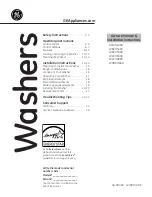
9
To remove the basket from the door
1.
Grasp the silverware basket by the handle. Slide it toward the
top of the door.
2.
Lift the basket off the holding buttons.
To replace the basket in the door
1.
Set the silverware basket on the holding buttons.
2.
Slide the basket toward the bottom of the door until it locks in
place.
NOTES:
■
Do not load silver or silver-plated silverware with stainless
steel. These metals can be damaged by contact with each
other during washing.
■
Some foods (such as salt, vinegar, milk products, fruit juices,
etc.) can pit or corrode silverware. Run a rinse cycle if you do
not have a full load to wash immediately.
DISHWASHER USE
Detergent Dispenser
The detergent dispenser has 2 sections. The Pre-Wash section
empties detergent into the dishwasher when you close the door.
1. Cover
2. Main wash section
3. Cover latch
4. Pre-wash section
The Main Wash section automatically empties detergent into the
dishwasher during the main wash. (See the “Cycle Selection
Chart.”)
■
Use automatic dishwashing detergent only. Other detergents
can produce excessive suds that can overflow out of the
dishwasher and reduce washing performance.
■
Add detergent just before starting cycle.
■
Store tightly closed detergent in a cool, dry place. Fresh
automatic dishwasher detergent results in better cleaning.
NOTE:
Do not use detergent with a rinse cycle.
Filling the dispenser
1.
If the dispenser cover is closed, open the cover by pushing
the Cover latch.
2.
Fill the Main Wash section with detergent. See “How Much
Detergent to Use.”
3.
Close the Main Wash dispenser cover. Fill the Pre-Wash
section if needed.
It is normal for the cover to open partially when dispensing
detergent.
NOTE:
Use both sections for cycles with 2 washes. Use only the
covered section for cycles with 1 wash. See the “Cycle Selection
Chart” for more details.
How much detergent to use
■
The amount of detergent to use depends on the hardness of
your water and the type of detergent. If you use too little,
dishes won’t be clean. If you use too much in soft water,
glassware will etch.
■
Water hardness can change over a period of time. Find out
your water’s hardness by asking your local water department,
water softener company, or county extension agent.
■
Different brands of dishwasher detergent have different
amounts of phosphorus for softening water. If you have hard
water and use a detergent with a phosphorous content of less
than 8.7%, you might need to use more detergent, or use a
detergent with a phosphorous content higher than 8.7%.
1
2
3
4
Where to fill
Top of 3rd step (3 tbs or 45 g)
Top of 2nd step (2 tbs or 30 g)
Top of 1st step (1 tb or 15 g)
Water Hardness
Amount of Detergent
Soft to Medium
Hard Water
0 to 6 grains per
gallon
For normally soiled loads
■
Fill the Main Wash section to the
top of the 2nd step (2 tbs or 30 g)
■
Fill the Pre-Wash section to the
top of the 2nd step (2 tbs or 30 g)
NOTE:
Add only 1 tb or 15 g of
detergent to both sections if dishes
are pre-rinsed or the water is very
soft (0 to 2 grains per gallon).
For baked on soil loads
■
Fill the Main Wash section to the
top of the 2nd step (2 tbs or 30 g)
■
Fill the Pre-Wash section to the
top of the 2nd step (2 tbs or 30 g)
For heavily soiled loads
■
Fill the Main Wash section to the
top of the 3rd step (3 tbs or 45 g)
■
Fill the Pre-Wash section to the
top of the 3rd step (3 tbs or 45 g)
Medium to Hard
Water
7 to 12 grains per
gallon
For normally soiled and
heavily soiled loads
■
Fill the Main Wash section to the
top of the 3rd step (3 tbs or 45 g)
■
Fill the Pre-Wash section to the
top of the 2nd step (2 tbs or 30 g)
if needed
Summary of Contents for DU960
Page 37: ...39 Notes ...










































